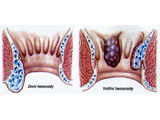Hemorrhoid surgery
Surgical intervention is reserved for patients with acute issues, in the case of repeated or long-term prolapse of internal nodes and if conservative treatment options have failed. Nonoperative methods are sclerotherapy, ligation (necking) of nodes with rubber rings, laser ablation, freezing with carbon dioxide and photocoagulation. By sclerotherapy is meant application of a substance that causes small-scale inflammation, with subsequent formation of scar tissue. Photocoagulation applies heat radiation to the tissues to destroy the nodes. Surgical procedures include several variants on resectioning the problematic issues. Acute problems include thrombosed hemorrhoids, which may be highly painful. The removal of blood clots brings immediate relief. The physician pierces the thrombosed hemorrhoid under local anesthetic and, creating an opening with the scalpel, excises the thrombosis. The area at which the operation is carried out is draped in a sterile cover. 12 hours after the procedure, the first sitz bath is possible.
Duration of surgery: 20 minutes
Length of hospital stay: 1–3 days


